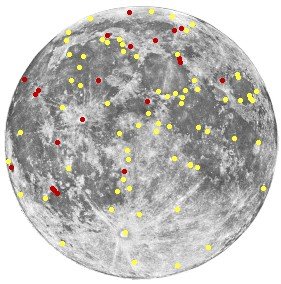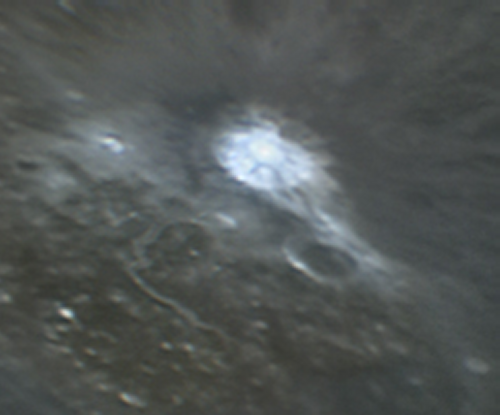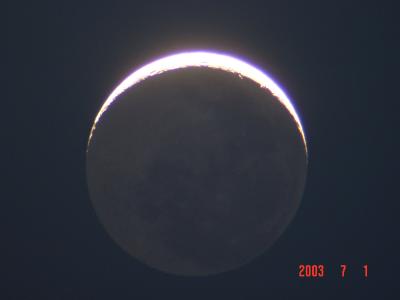|
Transient Lunar Phenomenon |
|
| Back Ground
A transient lunar phenomenon (TLP) refers to short-lived lights, colors, or changes in appearance of the lunar surface. Claims of short-lived phenomena go back at least 1000 years, with some having been observed independently by multiple witnesses or reputable scientists. Nevertheless, the majority of transient lunar phenomena reports are irreproducible and do not possess adequate control experiments that could be used to distinguish among alternative hypotheses. Few reports concerning these phenomena are ever published in peer reviewed scientific journals, and rightfully or wrongfully, the lunar scientific community rarely discusses these observations. Most lunar scientists will acknowledge that transient events such as outgassing and impact cratering do occur over geologic time: the controversy lies in the frequency of such events. Excerpt: Of the more than 1,500 LTP reports and events catalogued since the year 557 A.D., perhaps the widely publicized Alphonsus spectrograms of Kozyrev in 1958, the observations of Greenacre and Barr of Aristarchus in 1962, and the Project Moon-Blink reports of the 1960's, are the most familiar. There are many regions on the lunar surface, which have been suspected of LTP events. Rare and elusive as they may seem LTP events do appear to fall within roughly defined categories. Small, temporary reddish or pinkish patches, presumably due to fluorescence of incandescent gases, have been noted shortly after lunar sunrise, while glows lacking any distinct hue have been noticed, sometimes seen on the night hemisphere of the Moon. Emerging quite instantaneously or lasting for several minutes have been bright points of light near the lunar terminator or on the darkened hemisphere of the Moon, while rapid fluctuations in the brightness of a specific area have been occasionally recorded, again most often in the early lunar morning. Obscurations, visible directly as "fogs" or "mists", or indirectly by concealing or obliterating known surface features, are also frequently associated with times of lunar sunrise. Many variations have been reported in Earthshine conditions or in conjunction with partial or total lunar eclipses. SOURCE: ALPO
|
|
|
November 15, 1953 .
Image photographed: 11/15/1953 0200 U.T. by Leon H. Stuart – Tulsa, OK USA Photo courtesy the estate of Leon H. Stuart. 8" Reflector See Stuart's Event |
|
| Excerpt:
Rare and elusive as they may seem LTP events do appear to fall within roughly defined categories. Small, temporary reddish or pinkish patches, presumably due to fluorescence of incandescent gases, have been noted shortly after lunar sunrise, while glows lacking any distinct hue have been noticed, sometimes seen on the night hemisphere of the Moon. Emerging quite instantaneously or lasting for several minutes have been bright points of light near the lunar terminator or on the darkened hemisphere of the Moon, while rapid fluctuations in the brightness of a specific area have been occasionally recorded, again most often in the early lunar morning. Obscurations, visible directly as "fogs" or "mists", or indirectly by concealing or obliterating known surface features, are also frequently associated with times of lunar sunrise. Many variations have been reported in Earthshine conditions or in conjunction with partial or total lunar eclipses. Excerpt: In addition to the short-lived LTP events, observers are encouraged to monitor certain selected lunar features suspected of "seasonal" or long-term variations. An example of this would be a variation in the tone or hue of a given area, which cannot be attributed to varying solar illumination and which does not repeat systematically from lunation to lunation. These tonal changes usually occur where dark radial bands or dark haloes are seen within or around craters, or where darker regions exist within brighter areas on the lunar surface. In many (but not all) cases, unusual changes in the overall size and shape have been detected in conjunction with tonal or color fluctuations. Such features include Alphonsus, Aristarchus, Eratosthenes, Herodotus, Kepler, Messier-Pickering, Plato, Atlas, Ross D, Hell, Pico, Piton, and Colombo. - SOURCE The most frequent anomalous phenomena observed are:
|
|
| Description of events
Reports of transient lunar phenomena range from foggy patches to permanent changes of the lunar landscape. Cameron classifies these as: (1) gaseous, involving mists and other forms of obscuration,Two extensive catalogs of transient lunar phenomena exist, with the most recent tallying 2254 events going back to the 6th century. Of the most reliable of these events, at least one-third come from the vicinity of the Aristarchus plateau.
Mike's Astro Imagery UK Rotated Left 90 degrees. Caught during flow glow December 17th 2005 |
|
|
.
"So, there was Clem, cruising along over the farside, over a crater called Kowalski, at an altitude of about 2900 Km, snapping shots of the horizon. It was looking at the corona, like it did a lot. No big deal, just another orbit over the moon. Then a spot appeared on the horizon. Like someone had turned the lights on in a city. This is an image from the B startracker, from orbit 193. It is image LBA5904z.193 for those of you that have the CD set or want to try to get it from the NASA server. This is the full Clementine image unenhanced ,except it has been mirrored, to give the impression that we are on the farside. Because we are on the farside. Earth is on the other side of the moon to the left, we are looking west, toward the sun, while moving south in orbit..." Note: This image is also an example of the corona effect indicating that the Moon does have an atmosphere! |
|
|
Listing by Date .
Provided and copyright by: David Darling, Lunar Transient Phenomena Research The above photo was taken July 1, 2003 (9:46 p.m. Central Daylight Time) over Sun Prairie, Wisconsin and shows the crescent Moon and earthshine -- the darkened portion of the Moon's disk faintly illuminated by sunlight reflected from Earth. The bright feature on the western edge of the Moon is the crater Aristarchus. Over the centuries, this crater has been seen, even with the naked eye, shinning in the earthshine region, giving rise to stories of stars being seen on the face of the Moon. The photograph was taken using an Orion AstroView 120ST EQ Rich Field Refractor telescope, with eyepiece projection, 22mm eyepiece, and Sony digital camera DSC P71. |
|
| August 18, 1787
William Herschel the Astronomer who discovered Uranus. On the 18th of August 1787, Herschel looked through his telescope and saw a glow on the dark half of the crescent moon that resembled “Slowly burning charcoal thinly covered with ashes”[A] November 12, 1787
September 26, 1788
July 1821
|
|
| 1. W. Cameron. Analyses of Lunar
Transient Phenomena (LTP) Observations
from 557–1994 A.D.
2. Barbara Middlehurst, Jaylee Burley, Patrick Moore, and Barbara Welther (1968). "Chronological Catalog of Reported Lunar Events". NASA TR R-277 in zipped html format 3. Lunar Transient Phenomena Catalog NASA July 1978, NSSDC/WDC-A-R&S 78-03 in Pdf 4. Lunar Transient Phenomena Catalog Extension, Winifred Sawtell Cameron, July 2006, Extension in Pdf 5. Lunar Transient Phenomena: What Do the Clementine Images Reveal? |
|
| FAIR USE NOTICE: This page contains copyrighted material the use of which has not been specifically authorized by the copyright owner. Pegasus Research Consortium distributes this material without profit to those who have expressed a prior interest in receiving the included information for research and educational purposes. We believe this constitutes a fair use of any such copyrighted material as provided for in 17 U.S.C § 107. If you wish to use copyrighted material from this site for purposes of your own that go beyond fair use, you must obtain permission from the copyright owner. | |
|
|





